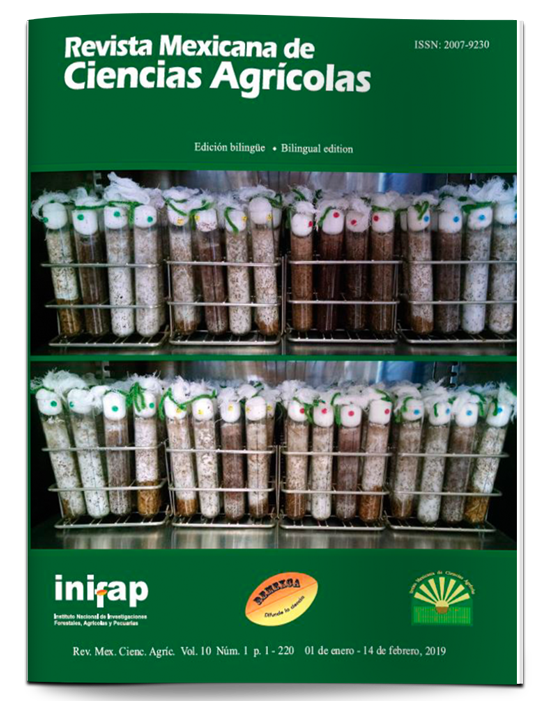Distribution of fungi associated with chickpea root rot
DOI:
https://doi.org/10.29312/remexca.v10i1.1730Keywords:
Fusarium oxysporum f. sp. ciceris, Fusarium solani, Macrophomina phaseolina, Rhizoctonia solani, pathogenic potential.Abstract
In northwestern Mexico, one of the constraints for the production of chickpeas are root diseases caused by a complex of soil fungi. Identifying and determining the distribution of these fungi in the areas used to plant chick-pea will allow defining the lowest risk of damage to the crop. During the autumn-winter 2012-13 cycle, 46 fields planted with chick-pea were sampled and geographed in the coast of Hermosillo. The 221 plant samples with symptoms of root rot were collected, and 197 fungal isolates were obtained in the laboratory. After their purification and classification, the individual isolates showed the typical morphological characteristics of Fusarium oxysporum f. sp. ciceris, Fusarium solani, Macrophomina phaseolina and Rhizoctonia solani. A risk index for soil pathogens was elaborated, defined by the number of species causing the disease in each site sampled, and distribution mapping of each pathogen. In 34 142 potential hectares of the agricultural area (22.5%) the risk index was low with a different species isolated through the sampling sites; 62 238 ha (41%) were detected with two different species and considered as medium risk areas. As high risk areas, where a complex of three pathogens was found in an area of 50 628 ha (33.3%) and with four pathogens considered as very high risk areas, 4 813 ha (3.2%). The species with the highest frequency of appearance in the coast of Hermosillo was Macrophomina phaseolina with 41% in the samples and in 77% of the sampled fields.
Downloads
Downloads
Published
How to Cite
Issue
Section
License
The authors who publish in Revista Mexicana de Ciencias Agrícolas accept the following conditions:
In accordance with copyright laws, Revista Mexicana de Ciencias Agrícolas recognizes and respects the authors’ moral right and ownership of property rights which will be transferred to the journal for dissemination in open access. Invariably, all the authors have to sign a letter of transfer of property rights and of originality of the article to Instituto Nacional de Investigaciones Forestales, Agrícolas y Pecuarias (INIFAP) [National Institute of Forestry, Agricultural and Livestock Research]. The author(s) must pay a fee for the reception of articles before proceeding to editorial review.
All the texts published by Revista Mexicana de Ciencias Agrícolas —with no exception— are distributed under a Creative Commons License Attribution-NonCommercial 4.0 International (CC BY-NC 4.0), which allows third parties to use the publication as long as the work’s authorship and its first publication in this journal are mentioned.
The author(s) can enter into independent and additional contractual agreements for the nonexclusive distribution of the version of the article published in Revista Mexicana de Ciencias Agrícolas (for example include it into an institutional repository or publish it in a book) as long as it is clearly and explicitly indicated that the work was published for the first time in Revista Mexicana de Ciencias Agrícolas.
For all the above, the authors shall send the Letter-transfer of Property Rights for the first publication duly filled in and signed by the author(s). This form must be sent as a PDF file to: revista_atm@yahoo.com.mx; cienciasagricola@inifap.gob.mx; remexca2017@gmail.
This work is licensed under a Creative Commons Attribution-Noncommercial 4.0 International license.



